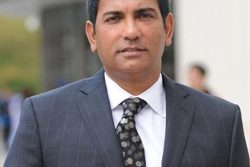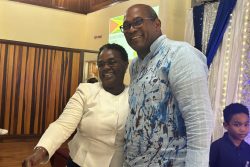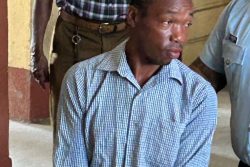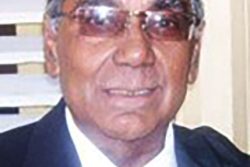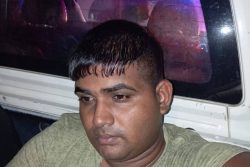Dear Editor,
As we observe this historic occasion, we recognize how significantly the ancestral presence from India that started 175 years ago, has left its unique stamp of ‘Indian-ness’ on Guyana.
The labour, sacrifices and struggles of hitherto bonded servants have helped to build the base of our nationhood and continue to shape our general outlook and mould our evolving Guyanese personality. Indo-Guyanese have since earned respect here and abroad as a distinct nationality.
When I visited India in 2008 to receive a Community Merit Award from the Global Organisation of People of Indian Origin (Gopio), I interacted with other look-alikes, whom I would have seen as Indians, but who were to proclaim proudly that they were Malaysians, Fijians and Sri Lankans, except that they all spoke Tamil and Hindi fluently. In their presence, I felt relieved to say that I am a Guyanese, whose paternal grandfather came to the then British Guiana in the late nineteenth century from what were the Madras provinces.
Earlier, in the 1980s, I had trouble explaining my Indian ethnicity and my Guyanese nationality. Some of my Indian colleagues
had refused to accept me as anything besides an Indian.
“Look at his eyes,” the Chief Minister of Uttar Pradesh was to tell my friends as I was being introduced to him in New Delhi. “He is from Andhra.”
There was no doubt that he was trying to cast me correctly. “He is,” he added, “definitely from Andhra!”
So there was no mistake that I could be Indian, albeit from the south of India, perhaps from the lower castes. It took some effort to explain that I could be of some other nationality or anything else. In Delhi, whilst I was at the Palika Bazaar, lost among thousands, I looked ‘Indian’ all right. I resembled the shopkeepers at whom I was looking with friendly curiosity. They stared at me with commercial interest. Somehow, I felt foreign.
“Where you from, Sah?” one shopkeeper asked.
I could have said Kerala or Tamil Nadu, and would have gotten away with that, but I said, “Guyana.” I saw that that posed a problem. So, I added, “West Indies.”
“Why, yes! Alvinnn Kallicharrannn! Yes, he always shops here!”
I felt relieved to be considered a West Indian, and caricatured as such in the likeness of my friend, Alvin, who was a celebrated player/captain of the West Indies cricket team!
At the Taj Palace Hotel, I was at a buffet dinner navigating the tables for less spicy foods. A colleague in sari saw my dilemma, and commented sarcastically, “Oh, my! We should have ordered some English foods!”
So, I was English, no doubt by accident of birth and political geography. Indeed, I was born in British Guiana three months or so after India gained her Independence. I grew up as an Indian. It would have been unthinkable that I should have seen myself as ‘British’ though years later, whilst in Suriname, I was to find out that Guyanese were generally called “Englishmen”. And Guyanese called our eastern neighbours “Dutchmen.”
However, over the years my ethnicity and nationality seemed to have blended harmoniously and defined me. I evolved into a Guyanese of Indian origin – an Indo-Guyanese, for short.
The point that I seek to illustrate is that our Indian ancestry does not automatically make post-indentured Guyanese, who were born in Guyana, ‘Indians’ or ‘East Indians.’ If we were born in Pakistan, we would be ‘Pakistanis,’ simply because we all have peculiarities fashioned by history, geography and nationality.
This was explained quite lucidly several years ago in a Stabroek News editorial titled, ‘The problem with ethnic identity’ (May 15, 1999):
“We were a British colony for over 160 years. During that time, we absorbed an enormous amount of British culture, the language, the educational system and the literature… the legal system, the business and commercial practices, the structure of government.
“In the course of this long transition a lot of old culture rubbed off and we are now quite different creatures to our original countrymen who never left home as is readily proved by a quick visit to the land of our forefathers where we may find ourselves unable to speak the language, most certainly be treated as a foreigner and feel quite out of place in many ways.”
During 1979 while I was in Guadeloupe I met a group of elderly, Indian women adorned with madras rhumals on their heads. My mother’s face was mirrored on theirs. They were smoking unfiltered cigarettes and drinking white rum. I spoke to them in English, and they replied in French.
We looked the same, but we were different by our history and local conditioning. However, even in this difference we could identify a cultural affinity when I shared their massala crabs and bygaan curry. I knew that we culturally shared a common ‘Indian-ness,’ though the women would have preferred to call themselves ‘Guadeloupeans,’ and I would have introduced myself as a ‘Guyanese,’ if we could have understood each other’s language.
I raised this notion of our ‘Indianness’ and ‘Guyaneseness’ to show that as an ethnic grouping while there are many influences that shape our identity, there are cultural traits that are inherent in us. We cannot rid ourselves of these and still remain the same. So, when I say, “I am Guyanese,” I would not negate my Indian ethnicity. My ‘Indianness’ has been woven into a distinct identity ‒ a personality that is Guyanese. It is for ethnic identification perhaps that we coin the appellation, ‘Guyanese Indian’ or ‘Indo-Guyanese.’
This identity difference has raised a polemical issue between who is Indian from who is Guyanese Indian or West Indian. Stabroek puts it rather bluntly: “For a Guyanese Indian to describe himself as Indian is in an important sense false as he is in fact far more West Indian or Caribbean in views and outlook than he is Indian.”
No doubt we are inside the salad bowl, a mixture of several influences. But the descendants of Indian immigrants, today’s Guyanese Indians, have imbibed much from Indian culture which is still dominant in our total way of life. It is everything that is inherited and acquired and passed on from generation to generation, most of it is religion-based, or in art forms such as sculptures and architecture, and in our occupation.
In Guyana, Indian culture is visible in our music, dance, poetry, symbols and even gestures. People say they can tell who is a Guyanese Indian from others, by the way the person moves his/her head or hands. Indian culture is reflected in our cuisines, for example, the peppery, hot food of Andhra Pradesh and the coconut-based curries of Kerala; the marriage customs, death rites, religious rituals, etc.
But there is also the culture of thrift, and the culture of resistance. It is well known that throughout the period of indentureship and afterwards, Indians lived under appalling poverty. However, historians have shown that through calculated withdrawal into their culture, Indians survived. Part of that culture was work and thrift, and investment in children as economic future, which have passed on to succeeding generations.
This is also true for Indians in South Africa, Kenya, Uganda, Mauritius, Burma, Trinidad, Suriname, Guyana and elsewhere in the so-called Indian diaspora.
The preservation of Indian culture, however, was a saga of courage. In his epic book, Tigers in the Stars, Dr Clem Seecharan documented the difficult work of Canadian missionaries to convert Indians in the early part of this century. Rev E H Johnson noted this resistance among East Indians: “anything that appeared to draw their children away from their customs… Isolated among strangers, they seem to feel the need of vigorously preserving their national identity.”
That reference to “national identity” showed the affinity between the early Indians in British Guiana and their ‘Motherland.’ It was not spontaneous. It was a form of resistance by Indians everywhere to the subjugation of India by the British, who simultaneously exploited Indians in the colonies.
Though we see ourselves as second and third generation Indians, that resistance is still within our being. It has become the Indian influence on our Guyanese personality. We can never discount or discard the emotional/cultural ties between our foreparents and their Motherland, even whilst we recognise that the centre of our own being lies here in this Guyana mudflat.
Resistance has become part of the Indian culture, as outlined in a publication, Race, Class and Nationhood, which I co-authored with Dr Cheddi Jagan in 1988, on the occasion of the 150th anniversary of the arrival of Indians to Guyana. This included struggles and sacrifice at Devonshire Castle (1872); Non Pareil (1896); Friends (1903); Lusignan (1912); Ruimveldt (1924); Leonora (1939), and Enmore (1948).
These, together with more contemporary post-independence resistance to political/racial oppression and against inept, corrupt rule, demolished the stereotype of Indian Guyanese being cowardly, or that they would acquiesce to oppression, even when such oppression comes ostensibly from their own race.
Another aspect of Indian culture is that of thrift, the conscious effort to put aside something for hard times, or for investment. In his text, The History of East Indian Resistance on the Guyana Sugar Estates, Dr Basdeo Mangru wrote about what was perceived to be an Indian disposition “to melt down silver coins to make jewelry with which they bedecked their wives and children, and to their repatriation with small fortunes.”
He referred to accounts by W A Patton (Down the Islands – a Voyage to the Caribees) who noted how Indian women were decorated with earrings, necklaces and a “mass of bracelets, bangles, and circlets” and pounds of sterling silver beaten and moulded for their ornamentation and adornment. Perhaps, for this reason Alistair Hennessy wrote authoritatively about early Indian women as “the true carriers of culture, as many as two-thirds of whom may have emigrated alone ‒ widows, childless women, deserted wives, women escaping from the tyranny of custom or mothers-in-law.”
Well, I say, “hats off to our Indian women; our Ma, our Nanees and Ajees!” Mangru cited a letter in 1899 by ‘Demerarian’ which attempted an understanding of the sacrifices that were required to make savings, and which also explained an important aspect of the Indian personality:
“Coolies as a rule belt their waists as tight as they possibly can to save a little money to buy a cow, and however small the amount may be it is deposited in the Banks…We must not be envious of a Coolieman, because he takes a hundred dollars of our money home; we must first know how economical he was, and what misery he must have undergone to save it. In short, we must congratulate baboo for his denial and accumulation, and endeavour to help him in his immigrant career.”
George Lamming was to write in The West Indian People (1966) a special tribute to this when he commented:
“…those Indian hands – whether in British Guiana or Trinidad – have fed all of us. They are, perhaps, our only jewel of a true native thrift and industry. They have taught us by example the value of money; for they respect money as only people with a high sense of communal responsibility can.”
We have much for which we ought to be eternally indebted to our Indian ancestors. While our Indian origin should give us inspiration and strength, we must turn to our Guyanese nationality for our distinct identity. Our nationality confers on us legal rights and freedoms and beckons us to patriotic duties, together with all other Guyanese, to resist as our foreparents did; to challenge corruption and graft; to change the condition of our life; to make it better, truly free and, hope, like Rabindranath Tagore in Gitanjali: “In that heaven of freedom, my Father, let my country awake!”
Yours faithfully,
Moses V Nagamootoo
